PACHYSANDRA TERMINALIS, also known by its common name Japanese Spurge, is an old-time ground cover plant with versatile modern day use. Evergreen the year round, self-sustaining and always looks well. Originally native to Japan and parts of Asia, Pachysandra spreads by rhizomes to form a solid blanket of green. Ideal for partly shaded or full shade areas. Primarily does best in the shade and moist ground, but once established will grow in partly sunny areas with less moisture. Despite the fact that is evergreen deer avoid it as they do not like its taste.
PACHYSANDRA
Pachysandra is the perfect all around ground cover for those hard to plant shady areas where nothing else will grow.
Pachysandra is the only satisfactory plant that will grow as a ground cover under Pine Trees. This plant is used extensively under large spreading trees, back of buildings or in other situations too shady for grass to grow. Pachysandra will transform otherwise bare and ugly ground areas into attractive year-round cover. It is also very effective as a border plant along paths or driveway edgings.
In Mid-Spring Pachysandra Terminalis plants produce tiny white flower spikes which add a bit of interest and have a sweet fragrance.
Pachysandra grows at an even height of about 8 inches, giving a perfectly flat top effect even for the largest areas. Perennial and long-lived, Pachysandra develops deepest dark green color in partly or fully shaded areas, where few other plants can succeed.
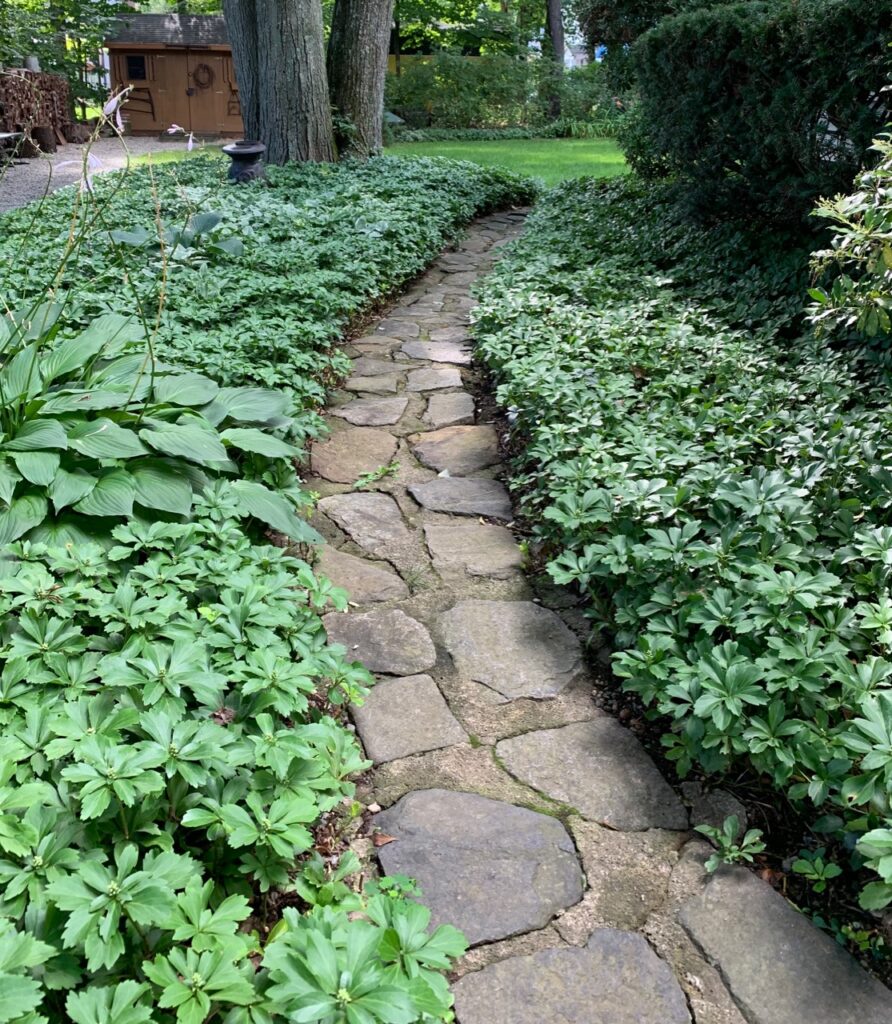
For greatest success, Pachysandra should be planted at six inch spacing, or four plants per square foot.
Our planting guide provides step by step instructions and tips for planting and growing Pachysandra:
Remember - Once established, a Pachysandra planting will eliminate grass cutting and weeding. Your lawn work stops at the edge of the lawn.
Frequently Asked Questions
How to plant and care for Pachysandra
Pachysandra is very easy to plant, and once established fills in areas completely. While it can seem intimidating at first when several hundred or perhaps even several thousand arrive in the mail, they are not time-consuming to plant. For many of our long-time customers the annual “Pachysandra planting” has become a tradition that the whole family gets involved with–it can be a lot of fun! Following the steps below will help to ensure success:
Preparatory to planting, loosen or pulverize the entire ground area. Enrich, if needed, with decayed stable manure, decayed leaves, or with peat moss. Pachysandra thrives in soil with an acidic PH of around 6.0., and peat moss, which is mildly acidic with a PH of 4.5, will assist in lowering the PH of the overall soil.
Loosen the overall soil to a depth of 3-4 inches.Where roots from trees are close to the surface, such as under maples, lindens or elms, cut these surface roots to three or four inches deep with a sharp grub-hoe; then, add 3 to 4 inches of new topsoil as explained. In such well-prepared areas, the roots will spread quickly.
Most soils are suitable to the growing of Pachysandra and other Ground Cover Plants and require no more work than digging the earth a few inches deep before planting is done. Your particular soil may not be poor, but if there is doubt, it is well to follow the ground preparations as outlined.
The best tool we have found over the years of planting literally MILLIONS of Pachysandra plants is a simple masons trowel, simply open up a small pocket in the loosened soil, place in the plant and lightly tamp around the base of the plant.
The first watering after planting should be thorough. Subsequent watering the first season is beneficial, and may be needed, especially in periods with no rain. Do not allow plants to wilt, the sign of insufficient moisture. It is very important to remove weeds by hand the first and second years. Tool cultivation is apt to destroy the many underground stolons (spreading root leaders) which continue to grow and form new stems during the Spring and Summer months.
Once Pachysandra is established fertilizing is an easy way to help them to quickly spread and thrive. In the early spring, a general purpose granular fertilizer can be applied to encourage growth, a good one being Holly-Tone, which is made for acid-loving plants. For the occasional boost throughout the season, liquid plant food Mir-acid, which is Miracle-grow for acid-loving plants, can be applied. In the fall, a second granular fertilizer application can be made to help the plants get ready for spring.
A common question that we are often asked is can PACHYSANDRA grow in sunny locations? The answer is yes, provided some parameters are met. Pachysandra prefers shady to partly sunny areas, but can grow in areas with more sun provided that they are provided with plenty of water, and the roots are kept cool. Irrigation from a system on a regular basis is a good way to achieve this. The leaves will generally become a lighter shade of green to adjust to the bright sunlight, which is not to everyone’s taste. If this lighter color is not a concern Pachysandra can be planted in sunnier areas, and if a large prexisting planting has lost some shade-cover, this is also a good way to attempt to preserve the bed and keep the plants healthy.
PACHYSANDRA TERMINALIS CULTIVAR VARIETIES
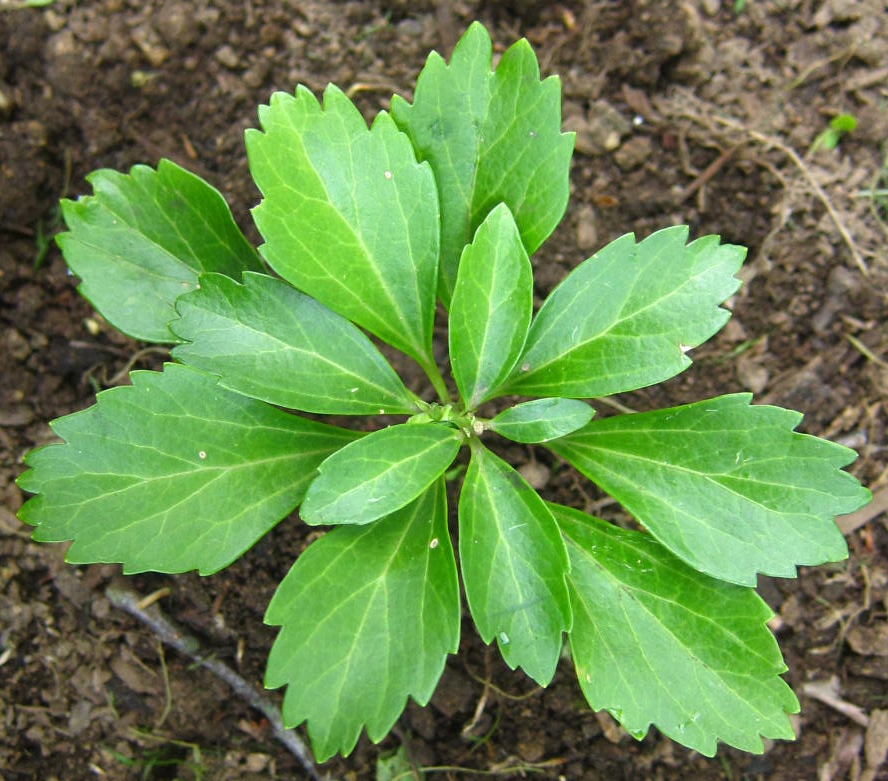
Common Pachysandra Terminalis
Many people are not aware of the fact that in addition to common Japanese Spurge shown above, there are several more rare and highly unusual varieties of PACHYSANDRA seldom offered for sale elsewhere. If you would really like to add some interest to your garden we highly recommend thinking about some of our PACHYSANDRA cultivars, each with its own unique qualities
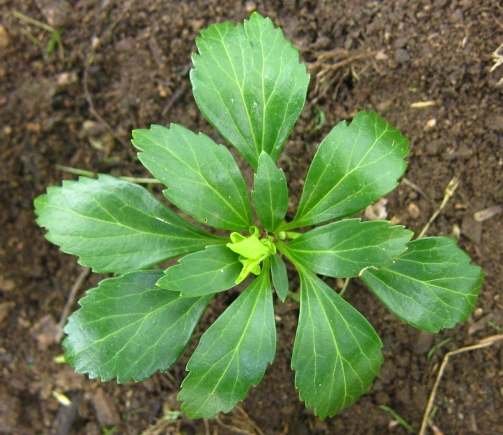
Green Carpet is another fine cultivar that distinguishes itself by having a deeper green leaf with prominent veining, more toothed edge, and waxy gloss to the leaf. This muted sheen is shinier than the regular variety but less than that of Green Sheen. Green Carpet also grows 2″ shorter than common Pachysandra for a more compact look.
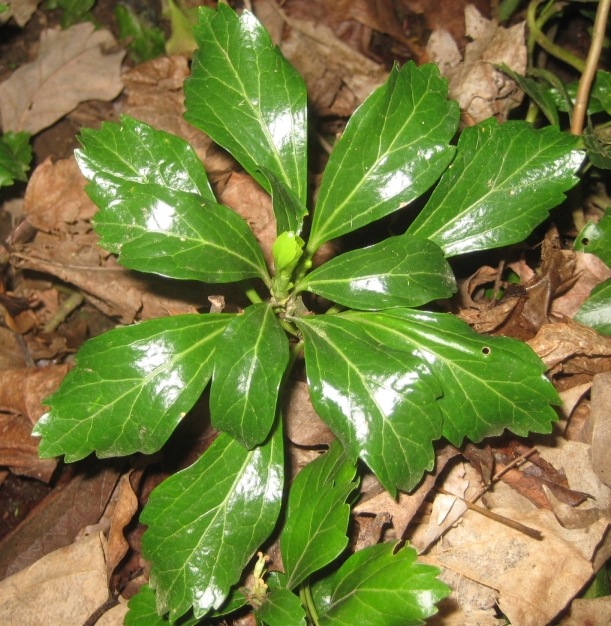
Green Sheen is a perennial favorite that is hard to find anyplace else! The plants have the most amazing sightly curled deep green glossy leaves that truly shine and look “wet” at all times, almost as if they were dipped in lacquer. A real favorite here at Peekskill Nurseries.
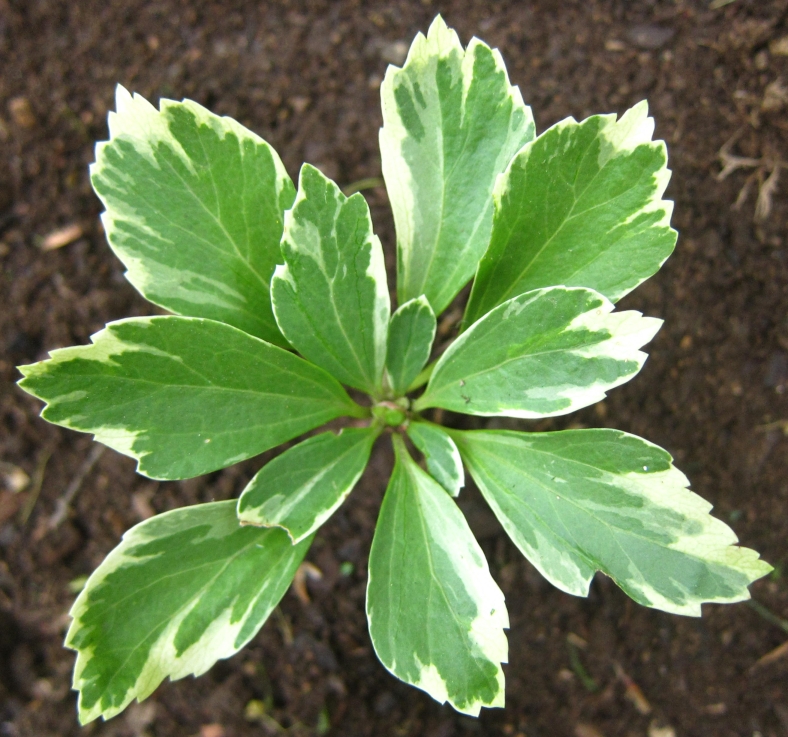
Silver Edge, or Variegated Pachysandra, have a lighter green colored leaf than the common type bordered with a delicate creamy white edge. They also have slightly “crinkled” leaves for added visual interest.
In this side-by-side photo, one can see the difference between Common Pachysandra Terminalis on the left and Green Carpet on the right. Note that the Green Carpet a darker shade of green, with longer more toothed leaves. Green Carpet also has more visible veining and a slight gloss to the leaf.
Pachysandra does well in a good, loose, fertile soil with an acidic pH under 6.0. Fertilizers for acid-loving plants such as Holly-Tone can be amended into the soil sparingly in spring each year to help with new growth.
No other plant can give a complete satisfaction that Pachysandra does. It has proven itself perfectly hardy in practically every section of the U.S. and Canada. You can plant almost any time of the year – March through December. Strong husky plants in outside soil frames. Plant 6 inches apart.
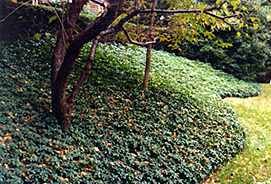
Bank Planted with Pachysandra Terminalis
FIRST TIME ORDERING PLANTS ONLINE BY MAIL?
Many of our customers have never purchased from a mail-order nursery, and consequently are concerned about the ordering process and the health of the plants after shipping.
Do not dismay!! All of our plants are hand-sorted for quality and health before being shipped, and with our shipping methods most orders arrive within four days of being shipped for most places in the nation. Plants offered for sale are competitively priced significantly lower than other suppliers, as a simple online search will prove. Prices are discounted for quantity and can be found in our online nursery shop.
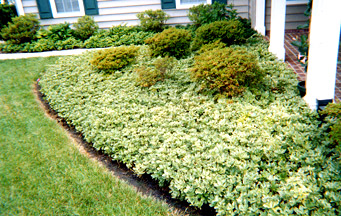
Garden-Bed Planted with Variegated Pachysandra
WHAT ARE BARE ROOT PLANTS?
All of our PACHYSANDRA plants are sold bare-root. These are non-dormant complete and healthy plants with leaves ready to grow and not, as the name may suggest, just clumps of roots! Bare-root simply refers to the way the nursery stock is presented for sale. All of our ground cover plants are grown and just prior to shipping all of the soil is shaken off the roots. The now “bare-roots” are then wrapped either in plastic or wax paper wrap. This is to save the customer on shipping costs and makes for stock that is easy to plant. While processing the plants in the manner, we also ensure that each plant is inspected for root health prior to shipping. The plants are hardy and can handle transport as the roots stay moist for the entire length of shipping. Plants should be planted promptly upon arrival to ensure success.
For large orders of 5000 of or more plants-contact us direct for wholesale pricing.
Growing Pachysandra from seed?
We are asked on occasion about the sale and production of PACHYSANDRA seeds. PACHYSANDRA produces white fruits in autumn that contain small seeds, but it usually takes some work to even find the fruits as they are seldom produced in any great quantity. This is because PACHYSANDRA requires cross-pollination of its flowers to produce the fruits, and many colonies that fill entire beds are “clonal” produced by spreading of Rhizomes (creeping roots) from the original plants. Consequently, they are all genetically identical and incapable of fertilizing each other.
Even if PACHYSANDRA produced seeds in great quantity, the time required for them to grow into a fully-developed plant would be far longer than cuttings, making seeds not practical for production. All of our plants are produced using cuttings from high-quality hardy specimens.
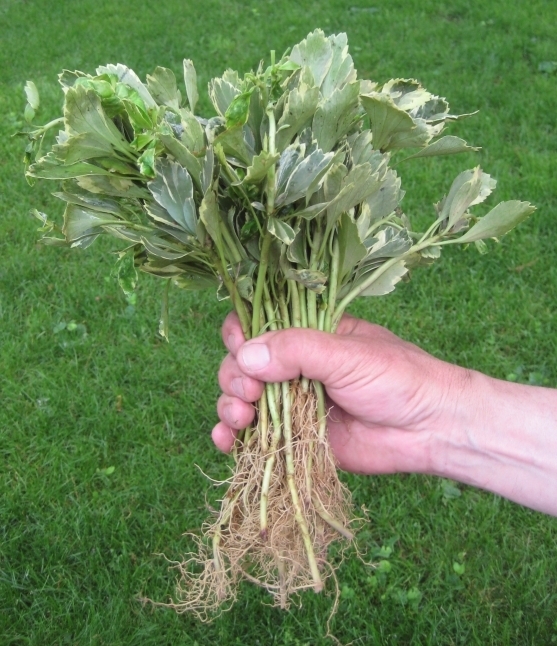
Bare-root Silver Edge Pachysandra ready for planting
Is your Pachysandra Dying?
If your Pachysandra is dying off take a close look at the leaves and stems. Concentric rings of black and brown spotting on yellowing leaves, as well as shriveling black or brown stems may be a sign that your Pachysandra bed is infected with Pachysandra Blight scientifically known as Volutella Pachysandrae. This fungal infection spreads through spores, and can rapidly destroy a long established bed of plants. Pink spore clusters may be seen on dying leaves and stems. Most Pachysandra beds will always have a small amount of Pachysandra blight present, but stress and injury allows the fungus to spread and take hold. Winter damage from wind burn, frost or ice laying on the plants can weaken them, allowing the blight to take hold if spring is wet with frequent showers and high humidity, which keeps the beds overly moist and ideal for the spread of blight. Equally dangerous are periods of extreme drought, which can weaken the plants, causing them to lay flat and wilt and become much more susceptible to infection.
Treatment of Volutella Blight
Do not delay in treating the plants affected by blight, or the whole bed may be lost! Rake the area of matted or wet leaves that may be holding fungal spores, and cut back badly diseased plants. Remove diseased material and dispose of it in regular garbage or by burying it–do not compost this debris as it can then infect your compost pile. Then apply a general purpose fungicide, containing the active ingredient Chlorothalonil, a common brand name fungicide with this active ingredient is Daconil, which can be found in most hardware stores and Garden Supply centers. Follow the directions and apply the treatment as a spray every 7-14 days until the plants begin to appear healthy.


